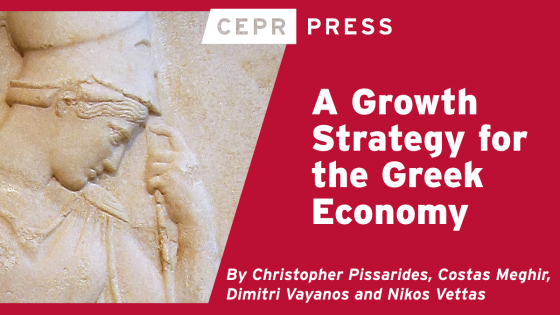Rapid post-war growth took Italy's GDP per capita above the OECD average by 1980s. However, since the mid-1990s, Italy’s economic growth faltered and GDP per capita rapidly deteriorated relative to the Eurozone and OECD (Figure 1). In particular, total factor productivity (TFP) flattened out in the mid-1990s and started to decline thereafter. Overall, TFP in Italy declined by 0.3% per annum in 1998-2014, while increasing in other Eurozone countries, and even more in non-EU countries (Figure 2).
Past research has highlighted the structural weaknesses of the Italian economy at the root of low growth, including rigidities in product and labour market, insufficiently developed capital markets, a structure of taxation weighing excessively on productive factors, as well as weaknesses in corporate governance and management, public administration, and civil justice (e.g. European Commission 1999, Buti 2009, Hassan and Ottaviano 2013, Mody and Riley 2014, Pellegrino and Zingales 2014, Toniolo 2014).

|
Source: Own calculation. GDP data are from OECD
national accounts, in 2010 purchasing power standards.
|
Source: Own calculation. TFP data are from OECD productivity database.
|
Our contribution (Pinell et al. forthcoming) takes a step further in two ways.
- First, it benchmarks Italy over time vis-à-vis Eurozone and OECD countries using structural indicators in the area of human capital, product market regulation, taxation structure, and innovation.
The analysis shows that Italy's gaps in these areas have grown over the last 15 years and are particularly large for human capital.
- Second, it simulates the impact of a package of growth-enhancing reforms that would close Italy’s gap to the average of the three best performers in these areas.1
The simulations show that structural reforms could boost growth. Reform momentum in Italy has picked up but, given the very nature and the size of the gaps, reforms will take time to bear fruit, leaving no room for complacency.
Italy’s structural weaknesses
Italy has the lowest share of population with tertiary education and the fourth highest share of population with only basic education in the EU (European Commission 2014). This gap also concerns young generations, implying that it will take a long time to revert. The difference is striking with respect to potentially competing economies such as South Korea, Spain, and Poland (Figure 3). The recent skill survey of the OECD shows that such low attainment rates translate into low skills (Figure 4). Moreover, the difference between the average skills of 16-25 year-olds and the average skills of 45-54 year-olds is smaller than in other countries with similar levels of skills in the whole adult population, indicating that the gap is set to grow over time (OECD 2013). The low rate of human capital reflects the low returns to education and skills, particularly for the young (Hanushek et al. 2013). The recent reforms in the labour market and education system, once implemented, could correct market signals and reinforce human capital accumulation in the long-term.2

|
Source: Own calculation. Data from Barro and Lee 2.0 (2014). http://www.barrolee.com/
|
Source: Own calculation. Data from OECD Survey of Adult Skills 2013 (PIAAC).
|
Italy has reformed its product market regulations more than other countries over the last 15 years (Figure 5). The reforms are bringing some results. Mark-ups in the service sector have indeed decreased with respect to earlier estimates and they are now below the Eurozone average (Varga and in 't Veld 2013, OECD 2007). Further market opening measures are being discussed in Parliament.3 However, Italy's business environment remains highly unfavourable. The costs for starting up a business remain higher than in nearly all other OECD countries. Furthermore, progress over the last ten years has been less rapid than in Greece, Spain, and Portugal, which now outperform Italy (Figure 6). This indicator, albeit imperfect, serves as a proxy for the broader weaknesses in public administration and civil justice, which slow down the reallocation of production factors.

|
Source: Own calculation. Data from OECD, Indicators of
Product Market Regulation.
|
Source: Own calculation. Data from World Bank, Doing Business indicator.
|
Italy's gap in R&D and innovation is also large and growing. Looking at the input side, Italy's business R&D spending in 2013 was 0.68% of GDP, less than half the average in OECD countries (1.61% of GDP). Since 1998, it increased only by 0.19 percentage points, slightly less than average OECD countries (0.20 percentage points) but less than half compared with Germany (0.40 percentage points). Looking at the output side, Italy’s share in the global number of triadic applications in 2013 was 1.4%, a share that remains well below that of France and Germany (4.9% and 10.8%, respectively).4 The slow pace of technology innovation and absorption is also shown in the persistency of the country’s specialisation in low-to-medium technology sectors (Faini and Sapir 2005, European Commission 2014, Pellegrino and Zingales 2014).
Italy's capital markets remain underdeveloped, which may also hinder innovation and structural change.5 Figures 7 and 8 show Italy's low performance with regard to private equity and venture capital compared with those European countries for which data are available.

|
Source: Own calculation. Data from Eurostat.
|
Source: Own calculation. Data from Eurostat.
|
Finally, Italy has significant scope for making its tax structure more growth-friendly. Within the Eurozone, Italy has the highest implicit tax rate on labour (after Belgium) while the implicit tax rate on consumption is among the lowest.6 This is partly the heritage of previous fiscal consolidation efforts that relied heavily on labour taxation making the taxation structure gradually less favourable to growth (Figure 9). Conversely, the implicit tax rate on consumption is well below the Eurozone average. This is mainly because of the extended use of reduced rates and low tax compliance (Figure 10), which reduce VAT intake despite a relatively high standard VAT rate.7 Recent reforms are expected to reduce the implicit tax rate on labour by some 1.5 percentage points, closing about one fourth of the gap to the EU average. The measures are financed by spending cuts and an increase in VAT rates and excise duties.

|
Source: Eurostat
|
Source: CASE (2013), Study to quantify and analyse the VAT Gap in the EU-27 Member States, commissioned by the European Commission.
|
The need for urgent action
The indicators presented above serve as a benchmark for a set of stylised simulations in the QUEST model. Structural reforms that close the gap vis-à-vis the average of three best performers in the policy areas discussed above would increase the level of GDP by 23.8% above baseline over 50 years, half of which (12.1%) through productivity gains and the rest through increases in employment (see Table 1).8 The gains, however, are very limited in the short term.
In the long term, more than half of the cumulated impact of reforms would come from raising Italy’s educational attainment to the best performers in the EU. Because of cohort effects, however, the benefits materialise only very slowly; they are negligible after ten years and continue to accumulate after 50. The time lag could be shortened in that respect if measures are taken to foster the return of emigrates with tertiary education and increase high-skill immigration, the latter being among the lowest in the OECD.9
Reducing mark-ups, entry costs and the financing wedge on intangible assets would boost GDP significantly after 50 years, with large gains in productivity. Increasing government subsidies in the form of tax-credits to private R&D would have instead a limited impact on growth.
Shifting taxation away from labour onto consumption would induce a robust increase of employment, and thus of GDP, already in the very first years (with limited further gains thereafter), which could play an important role in helping the reform process at the beginning.
Conclusions
Fundamental structural weaknesses that hold back Italy's productivity and growth have gradually worsened relative to other Eurozone and OECD countries over the last 15 years. Important reforms are ongoing, but restoring healthy growth will require an extraordinary reform effort. Our analysis shows that given the nature and size of the weaknesses identified, reforms will need time to bear fruit, underscoring the urgency of moving decisively forward.
References
Brücker H, S Capuano, and A Marfouk (2013), “Education, gender and international migration: insights from a panel-dataset 1980-2010”, mimeo, data downloaded from http://www.iab.de/en/daten/iab-brain-drain-data.aspx on 30/10/2014.
Buti M, ed (2009), Italy in EMU: The Challenges of Adjustment and Growth, Cambridge University Press.
European Commission (1999), “Italy's slow growth in the 1990s: Facts, explanation and prospects”, European Economy N5.
European Commission (2014), “In-depth review of the Italian economy, European Economy”, Occasional Papers. 182. March 2014.
European Commission (2013), “Tax reforms in EU member states 2013”, p. 45-46.
Faini and A Sapir (2005), “Un modello obsoleto? Crescita e specializzazione dell'economia italiana”, in Boeri et al (2005), Oltre il declino, Il Mulino, Bologna, Italy.
Hanushek E A, G Schwerdt, S Wiederhold and L Woessmann (2013), “Returns to skills around the world: evidence from PIAAC”, OECD Education Working Papers, No. 101
Hassan F, G I P Ottaviano (2013), “Productivity in Italy: the great unlearning”, VoxEU.org, 30 November.
Mody A and E Riley (2014), “Why does Italy not grow?”, Bruegel.com, 30 October.
OECD (2007), “Product market competition in the OECD Countries: Taking stock and moving forward”, Economics Department Working Paper No. 575.
OECD (2008), “A profile of immigrant population in the XXI century”, pp. 82-83, Table 3.1.
OECD (2013), “The Survey of Adult Skills”, OECD Programme for the International Assessment of Adult Competencies (PIAAC).
Pellegrino B and L Zingales (2014), “Diagnosing the Italian Disease”, Working paper, University of Chicago.
Pinelli D, I P Székely and J Varga (forthcoming), “Italy’s productivity challenge”, ECFIN Economic Briefs
Toniolo ed. (2014), The Oxford Handbook of the Italian Economy Since Unification, Oxford University Press: Oxford, UK
Varga J, in 't Veld J (2013), “The growth impact of structural reforms”, in European Commission (2013), Quarterly report on the euro area, Vol. 12, Issue 4.
Varga J, W Roeger and J in ’t Veld (2014), “Growth effects of structural reforms in Southern Europe: the case of Greece, Italy, Spain and Portugal”, Empirica, 41(2), pp. 323-363,
World Economic Forum (2015), “Global competitiveness ranking”, http://reports.weforum.org/global-competitiveness-report-2015-2016/competitiveness-rankings/#indicatorId=GCI.B.08.01.
Footnotes
1 The set of simulations are those presented in Varga J., Roeger W., and J. in ’t Veld (2014), using the QUEST model and an additional simulation on the impact of reducing the financing wedge on intangible investment in the same model. The QUEST model is the global dynamic stochastic general equilibrium (DSGE) model developed in the Directorate-General Economic and Financial Affairs of the European Commission for quantitative policy analysis.
2 Law 183/2014 (Jobs Act) and Law 107/2015 (La Buona Scuola).
3 Atto Senato 2085 (Legge annuale per la concorrenza), already approved by the low Chamber in October 2015.
4 OECD, Main Science and Technology Indicators.
5 See for instance World Economic Forum (2015), according to which Italy ranks 117th out of 140 countries for financial market development.
6 The implicit tax rate on labour is calculated as the sum of all direct and indirect taxes and social contributions levied on employed labour income as a percentage of total compensation of employees from national accounts. The implicit tax rate on consumption is calculated as the ratio of all revenues from taxes on consumption to the value of private consumption in the country. Data are from Eurostat.
7 In October 2013, the standard rate increased by 1pp from 21% to 22%, the 11th highest in the EU.
8 Results are shown as deviation (in p.p.) from the baseline for each shock. The baseline is constructed using 2012 data. The total impact is the sum of individual impacts and it is not obtained by simulating all shocks at the same time. However, given the specific design of the model, the results are roughly linear. Reforms are introduced gradually, in particular: (i) entry costs, tax shift, R&D subsidies and financing wedge shocks are introduced linearly during the first 5 years; (ii) mark-ups are decreased by 1pp per year; (iii) skill levels are gradually increased over 25 years. For details, see: Varga, Roeger and in ‘t Veld (2014).
9 Italy's tertiary migration rate was 9% in 2010, higher than in the other large EU countries such as Spain (2%), France (5%) and Germany (8%). Data are from Brücker, Capuano and Marfouk, 2013. The emigration rate for country i and education level l is calculated by dividing the expatriate population from country i at level of education l by the total native-born population of the same country and level of education (p. 16, box 3). The share of tertiary educated in total immigrant population (15 years old and above) was 12.2% in 2005, lower than in any other OECD country apart from Austria (11.3%) and Poland (11.9%). The (weighted) OECD average was more than double (24%). See OECD (2008).









